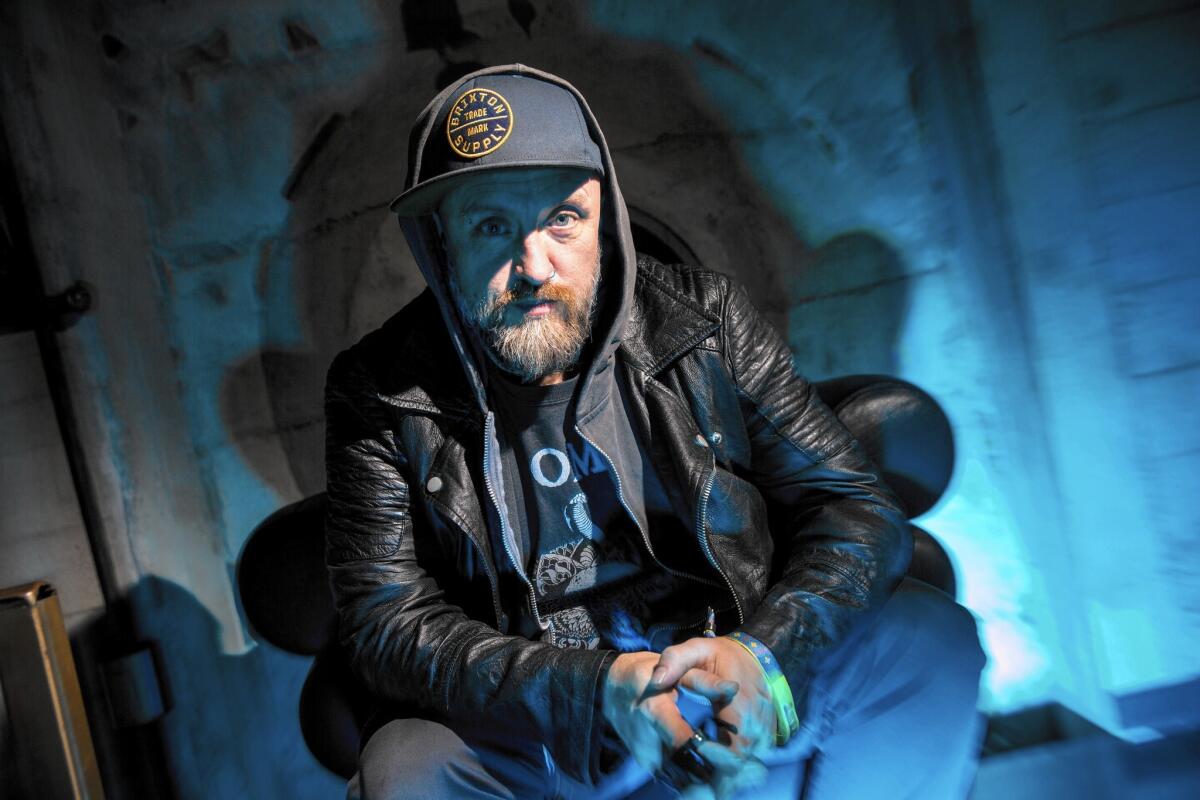British producer Kevin Martin transforms into a Bug. Then there’s his King Midas Sound

In the last 25 years, Kevin Martin has been a curator, a compiler, a writer, a musician, a producer and an ambient presence. On more than 150 recordings, he’s channeled his obsessions into the studio, then slowly built a reputation as a live artist.
Usually cloaked by a baseball cap and hoodie, going heavy on the glare, Martin has had a year the Internet would call low-key legit. His specialties are bass, noise and dread, and he’s found the right delivery vehicles for all of them.
He’s moved through a half-dozen styles in his career, beginning in the sprawl of free jazz and abrasive guitars, then experimenting with refractions of bass music more easily used on dance floors. In the last five years, Martin has focused on a persona he calls the Bug and a project called King Midas Sound, a trio that includes vocalists Roger Robinson and Kiki Hitomi.
The Bug recordings are rooted in Jamaican dancehall and relatives like grime, the British mutation of rap. (Grime jumped back into view this year when veteran MC Skepta became fast friends with Drake and inserted his song “Shutdown” into the American slipstream.)
King Midas Sound is a quieter affair, building songs around glassy reflections of mixing desk feedback and pink noise.
“For King Midas, Roger and I both wanted to make songs, not club tunes — songs that were about intimacy and focusing on breakdown and melancholy in particular,” Martin said from Berlin over Skype before flying to L.A. to perform as the Bug this month. “We wanted to make heartbreaking songs, with dub, in 3-D.”
Dub’s fracture
“Dub,” he said, “is the key to everything I’ve wanted to do.”
This kind of statement comes easily to musicians — name-drop the right genre, feinting at modesty, while knowing you’ve claimed allegiance to some heavyweights. People rarely back it up, but Martin’s nonlinear career has been a sustained elaboration of dub methods.
Join the conversation on Facebook >>
Dub is Jamaican in origin, though the practice is simple enough to port out into any recorded music. In the early ‘70s, producers like King Tubby and Lee Perry began manipulating multitrack recordings, removing some or all of the vocals. Individual instrumental tracks were sent through effect units or simply taken out. The results could be used by DJs in combination with multiple copies of the same record to extend a song as long as desired. Soon after moving from Weymouth to London in 1990, Martin saw a live show that used dub’s fracture and reassembly as a live strategy.
“I went to a sound clash with two systems battling each other. Being in the middle, for me, was a sonic revelation,” Martin said. “It was Iration Steppas clashing with the Disciples. I’d never heard anything like it in my life. It was the most extreme bombardment, but deeply soulful and incredibly danceable. It was like funky warfare. I’ve never really recovered from that.”
This epiphany didn’t lead to Martin releasing anything that resembled dub, reggae or dancehall — not initially.
“God was the first proper band I ever formed,” Martin said. “It was an attempt to fuse noise rock and free jazz. The last lineup of the band, when I split it, was three bass players, a troop of African percussionists, two drummers, two guitarists, three sax players, one electric viola player and myself, screaming and playing sax through a wall of Marshall cabinets and effect pedals.”
God’s “Possession,” from 1992, sounds more like 1992 New York than Kevin Martin. The rhythmic patterns mimic the bass and drum tattoos undergirding early records by Swans. On top, Martin sang and played saxophone, accompanied by a host of noisemakers and percussionists making a crowded racket. The only elements derived from dub are long instrumental stretches and liberal use of echo. If the saxophone playing makes you think of downtown improvisers like John Zorn, that’s because Zorn is on the record. God was a reasonable facsimile of Lower East Side noise that didn’t add much to the original beyond a crisp mix and some heft.
The Bug’s life
Over the years, Martin began cycling through projects, many carried out with Godflesh guitarist and producer Justin Broadrick. In the late ‘90s, he started creating tracks openly indebted to Jamaican sources. Before releasing them to the public as the Bug, he first aired the music at a show he and Broadrick were playing in Switzerland.
NEWSLETTER: Get the day’s top headlines from Times Editor Davan Maharaj >>
“At the end of this Techno Animal set I said, ‘Hey, do you mind if I just stick on some of these Bug demos?’ Straightaway, all the dudes started disappearing and all their girlfriends moved forward. And then there were four girls jumping onstage and rocking out to the early Bug tracks. Justin and I were behind the mixing deck, laughing hysterically. That had never happened at our shows before.”
A reliable index of where an artist stands within a community is to track what other artists say without being asked. Musician Dan Lopatin, doing business as Oneohtrix Point Never and touring a live show in support of the “Garden of Delete” album, passed through L.A. a few weeks ago. Out of nowhere, he brought up Martin.
“Oneohtrix Point Never played a show with King Midas Sound in Bristol, in April of 2011. Watching that show helped me learn how to play live. I talked about it with Kevin. He said to me, ‘Just get all your stems, bring them up onstage, use a big mixing board, and then just play with all of it. Dub it out.’”
2015 was the year Martin’s dub clicked with his own past and the present of others. King Midas Sound collaborated with guitarist and electronic musician Christian Fennesz for “Editions 1.” The album is a smear of drones and chords devoid of beats. When Robinson and Hitomi sing, the vocals function as lyric and texture. It is a collection of haunted songs without rough edges. Perversely, the “Instrumentals” version of the album is the more raucous of the two. (“Instrumentals” is a dub version of “Editions 1” in everything but name.) Martin lays in foggy bass lines and buries dancehall rhythms underneath processing. The grain on this music is fine, the work of someone who has spent years in studios adding and subtracting elements. Either version of “Editions 1” is easy listening, in the literal, physical sense. Martin’s brand of confrontation now allows for lots of pleasure, some of it placid. “Editions 1” casts a flickering gray light, like a storm cloud 10 miles down the road.
As the Bug, Martin pulled off a sneaky triumph, covering the 1984 Prince Jammy production known as “Sleng Teng,” one of the best-known Jamaican riddims. Over four tracks called things like “Meth Teng” and “Skag Teng,” Martin quotes the bass line that Wayne Smith originally sang over, adds beats and submits the bundle to extreme distortion and enlargement. The clangorous guy from 1992 came back with more swing and a varied gray scale.
“The Bug vs. Sleng Teng” crams the data density of an LP into a 17-minute EP. Where King Midas is carefully scrubbed of bright tones, Bug’s “Sleng Teng” is all overdriven oranges and yellows. The moody guy in black may, goth forbid, have found a way to have a good time.
Miss Red, born Sharon Stern in Haifa, Israel, and now orbiting Berlin, is not averse to a good time. Collaborating with Martin, her “Murder” mixtape, delivered under the wire, is one of the year’s most lively releases. Her rhyming doesn’t ape traditional dancehall cadences or borrow patois intonation, meaning she lands closer to M.I.A. than to Sister Nancy. Working with his own beats and a few from producers like Evian Christ, Martin oversaw the whole affair. Investing in dancehall aesthetics for Miss Red reveals the springiness in Martin’s static and the space inside his low end. The closer he comes to re-creating that 1990 sound clash, the more he sounds like himself.
ALSO
The intersection of music and movies in 2015 sparks startling connections
The Beatles are coming to Apple Music, Spotify and other streaming services
How Taylor Swift, Adele and the Weeknd made 2015 a pivot point for pop producer Max Martin
More to Read
The biggest entertainment stories
Get our big stories about Hollywood, film, television, music, arts, culture and more right in your inbox as soon as they publish.
You may occasionally receive promotional content from the Los Angeles Times.





